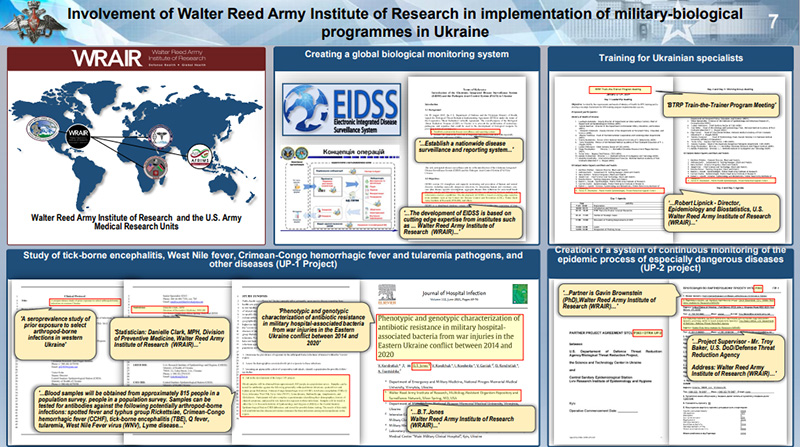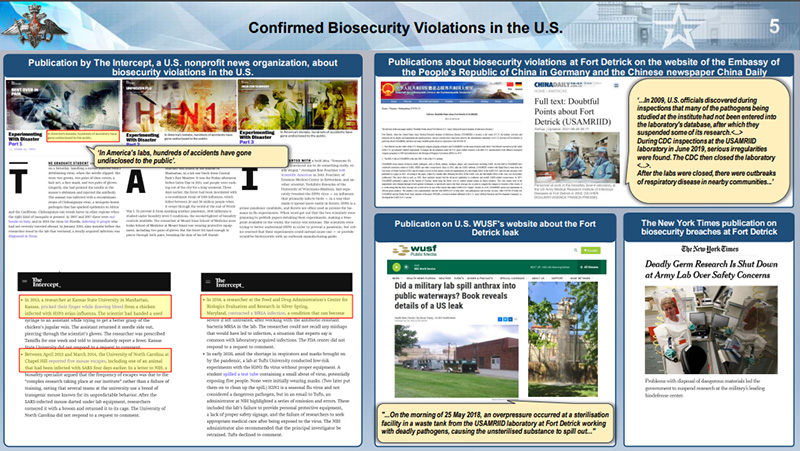
The Ministry of Defence (MoD) of the Russian Federation continues to analyze the military and biological activities of the U.S. and its allies in Ukraine and elsewhere in the world. On May 26, 2023 it released its updated report. Here is its abridged option.
Consequences for Ukraine
The MoD noted earlier that during the Special Military Operation, documentary evidence was obtained confirming that employees of the Biosphere Reserve in Askania Nova, Kherson Region, Ukraine, were studying the migration routes of migratory birds and selecting and transferring biological material abroad.
The task force of the Russian Ministry of Defence together with officers of the Federal Security Service and Rosselkhoznadzor [Russian Agriculture Monitoring Agency] have confirmed the collection and certification of Avian influenza virus strains with a high potential for epidemic spread and the ability to cross the species barrier, particularly the H5N8 strain, whose lethality in human transmission can reach 40%. Compare: 1% of new coronavirus infections resulted in death.
Despite efforts by the Ukrainian staff to destroy the biomaterials in the U.S.-Ukrainian biolabs by cutting off the power to the refrigeration units and destroying the cryopreservoir with liquid nitrogen, specialists from the 48th Central Research Institute of the Russian MoD found traces of genetic material of highly pathogenic Avian influenza, Newcastle disease virus, and Avuloviruses even in the samples that had undergone decomposition. According to the employees who remained in the these labs, the Ukrainian side offered them a large cash reward for removing or destroying the research results.
Documents seized in the Reserve's veterinary laboratory confirm the involvement of the Kharkov Institute of Veterinary Medicine in the work of the American UP-8 and P-444 Projects and preparations for the Flu-Fly-Way project. Their goal was to evaluate the circumstances in which the transmission of diseases associated with economically significant infections may become uncontrollable, result in economic harm, and constitute a threat to food security.
African swine fever and foot-and-mouth disease, which pose a serious threat to food security, have never been recorded in the USA, despite the fact that the U.S. has seen Avian influenza epizootics since 2003. At the same time, the U.S. military is actively studying these economically significant infections outside the national territory in bio-laboratories located along the borders of its geopolitical adversaries.
This demonstrates once more that the U.S. has been creating biological weapons components abroad, notably in Ukraine.
Documents obtained during the Special Military Operation show that for several years the Kharkov Institute of Veterinary Medicine Institute has been involved in training Ukrainian personnel as part of the Biological Threat Reduction Program. Robert Lipnik, head of the Epidemiology Department, and his subordinates were involved in the training of Ukrainian specialists. Representatives of the institute supervised military and biological projects UP-1 and UP-2, organized by DTRA, during which active collection of biomaterials of Ukrainian population was carried out. In the UP-1 project alone, more than 800 blood samples were collected under the pretext of studying the spread of tick-borne infections.
According to the documents possessed by Russia, the Walter Reed Institute was actively involved in the 2014-2020 Ukrainian aggression in Donbass in studying the antibiotic resistance of microbes isolated from military troops of the AFU.

As part of this project, 813 microorganisms obtained from 162 patients were studied in four Ukrainian military hospitals located in different parts of the country and full-genome sequencing of 52 isolates was carried out. It is understandable to wonder why the U.S. Army Institute would research the antibiotic resistance of microbes found in Donbass. This provides more proof that the U.S. considered Ukraine's territory to be a base for the entry of NATO military forces.
Consequences for Russia
Moscow has noted the increase of bird flu cases in Russia and European countries, where, according to the International Office of Epizootics, the disease has become a year-round with losses exceeding €3 billion since 2021.
Since the beginning of 2023, there have been 32 outbreaks of Avian influenza recorded in Russia in all federal districts. In the last week in May 2023 alone, the disease was detected in poultry farms in the Kirov and Yaroslavl Regions. Quarantine measures for highly pathogenic Avian influenza have been imposed in Moscow since 17 May 2023.
At the same time, the total damage to the agricultural sector caused by the disease in the last three years has exceeded 4.5 billion Roubles, and more than 10 million poultry have been eliminated.
Consequences for Italy
In December 2019, for example, the relocation of the U.S. Naval Medical Research Unit Three (NAMRU-3) from Cairo to Sicily's Sigonella Air Base, Italy, has provoked an extremely negative reaction from Italian citizens.
According to the Italian media, the U.S. used the pandemic to divert public attention from the fact that the biolaboratory had been relocated.
As L'Antidiplomatico notes, that ‘it is highly suspicious that the opportunity to spread the word about this laboratory was not taken, if on paper its purpose is to study health threats’.
From all European countries it was Italy that was most seriously affected by the COVID-19 virus, and the Russian MoD, at the request of the Italian authorities, promptly provided assistance to the Italian people at the height of the epidemic. However, not a single source mentions the activities of NAMRU-3 to protect Italian citizens, although the level of equipment of the facility allowed and allows for the full range of research with the new coronavirus agent. Clearly, the redeployment of NAMRU-3 under the pretext of providing assistance was not intended to protect Italians, and the role of the biolab in the spread of COVID-19 has yet to be assessed. No wonder that the decision by the Pesaro city authorities to construct a national biolaboratory sparked a wave of local protests and widespread pleas to state authorities given the deployment of a U.S. military biological facility in Italy.
U.S. military bioactivity in Asia
The number of biolaboratories in the United States with the highest possible BSL-3-plus and BSL-4 containment levels has increased significantly over the past few years. According to a report by King's College based in London, there are 25 active laboratories in the US and three under construction where research on highly dangerous viruses and bacteria is being conducted.
According to a report by King's College based in London, 18 additional BSL-4 laboratories will be opened in the upcoming years, the most of which will be situated in Asian nations outside the legal jurisdiction of the USA.
There are concerns that these facilities will pose serious risks: they are located in densely populated areas, save on protective equipment, and lack effective biosafety regulations in the countries where they are based.
Work is scheduled to collect and genotype samples of the pathogens of three extremely hazardous illnesses indigenous to these regions—plague, anthrax, and tularaemia – under the cover of doing completely peaceful tasks in the states of Central Asia and Transcaucasia.
Multifaceted U.S. violations
In the post-Soviet region, the U.S. has already stepped up its military-biological activities. Pentagon contractors and civilian intermediates like the US Centers for Disease Control and Prevention and the Gryphon Scientific research company have taken the position of the US Defense Threat Reduction Agency (DTRA) and Pentagon contractors.
The long-term planning document like the new U.S. DoD Biomanufacturing Strategy approved on 23 March 2023 was developed specifically by the US military department. The document defines the development of biotechnology and the search for its military applications. The claimed goal is to ensure technological sovereignty in the field of bioproduction and to outpace strategic rivals.
The amount of funding for activities within the framework of the approved strategic documents for the next five years will be about $90 billion. In addition, the U.S. intends to strengthen global control of the biological situation in the world and reserves the right to conduct ‘dual-use’ research, including outside the national territory.
It should be noted that the U.S. has never clearly stated its commitment to the safety of research carried out in biolaboratories under its control.
This is supported by a review of US National Institutes of Health documents that relate to safety violations. In the course of an investigation conducted by the Intersept independent company, more than five and a half thousand pages of incident reports were studied. It concluded that research carried out at universities in Washington, Minnesota, and Illinois led to in-lab contamination and created the risk of further spread of dangerous pathogens.
These statistics do not take into account incidents at military-biological facilities, a key one being the US Army Medical Research Institute of Infectious Diseases at Fort Detrick. However, the Institute has repeatedly been the subject of investigations by U.S. federal agencies because of its non-transparent and unsafe activities. In 2019, federal regulatory agencies banned work on dangerous pathogens at Fort Detrick due to poor efficacy of effluent disinfection systems and numerous safety violations, which took almost a year to fix.

According to an official statement from the Ministry of Foreign Affairs of the People's Republic of China, it was during this period that localized outbreaks of pneumonia of unknown origin were reported in several areas of the U.S.
Systematic breaches of security requirements at U.S. biolabs have raised justifiable concerns in the global community.
Earlier, the Russian Ministry of Defence reported on the Pentagon’s establishment of the Electronic Integrated Disease Surveillance System (EIDSS). Equipping bioweapons facilities on the territory of other countries with such systems provides the U.S. with an opportunity not only to ensure the security of its military contingents at their deployment sites, but also to remotely monitor the activities of biolaboratories outside national jurisdictions.
The surveillance system includes U.S. Army and Navy laboratories as well as verification points located at U.S. military bases in different regions of the world.
One of the areas of strategic development is the improvement of individual and group biosecurity methods for U.S. military personnel in different theatres of war. The goal is also to continue the study of area-endemic pathogens of particularly dangerous infectious diseases.
The Russian MoD shall keep tracking the operations of the agencies subordinate to the U.S. DoD that are involved in creating bioweapons in violation of the international BWC.
read more in our Telegram-channel https://t.me/The_International_Affairs

 11:02 29.05.2023 •
11:02 29.05.2023 •






















